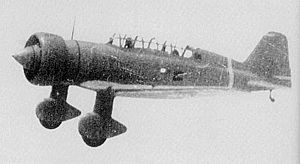Mitsubishi C5M
| Ki-15 "Babs" | |
|---|---|
 |
|
| Mitsubishi Ki-15-I (Army Type 97 Command Reconnaissance Plane) | |
| Role | Military reconnaissance aircraft, light bomber |
| Manufacturer | Mitsubishi |
| First flight | May 1936 |
| Introduction | May 1937 |
| Retired |
1945 (Japan) 1951 (China) |
| Primary users |
IJA Air Force IJN Air Service |
| Number built | approx. 500 |
The Mitsubishi Ki-15 (九七式司令部偵察機 Kyunana-shiki sireibu teisatsuki?) is a Japanese reconnaissance aircraft and a light attack bomber of the Second Sino-Japanese War and Pacific War. It began as a fast civilian mail plane. It was a single-engine, low-wing, cantilever monoplane with a fixed tailwheel undercarriage; it carried a crew of two. It served with both the Imperial Japanese Army and Navy (as the C5M). During World War II it was nicknamed "Babs" by the Allies.
The Ki-15 was designed by the Mitsubishi corporation to meet an Imperial Japanese Army Air Force requirement of 1935 for a two-seat, high-speed reconnaissance aircraft. The resulting aircraft was a low-wing cantilever monoplane with a fixed, spatted undercarriage, similar to other all-metal stressed-skin monoplanes developed elsewhere in 1930s, such as the Heinkel He 70 and the Northrop Alpha. Power was by a single Nakajima Ha-8 radial engine, giving 560 kW (750 hp) at 4,000 m (13,120 ft). The first prototype flew in May 1936, with testing proving successful, the aircraft meeting all performance requirements, reaching a speed of 481 km/h (299 mph) and showing good handling characteristics.
...
Wikipedia
